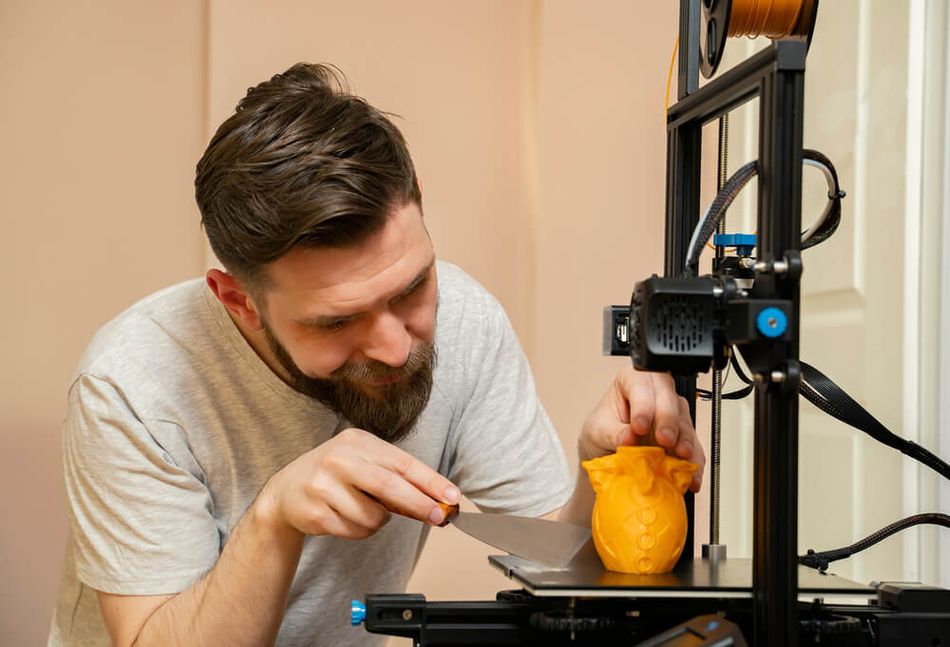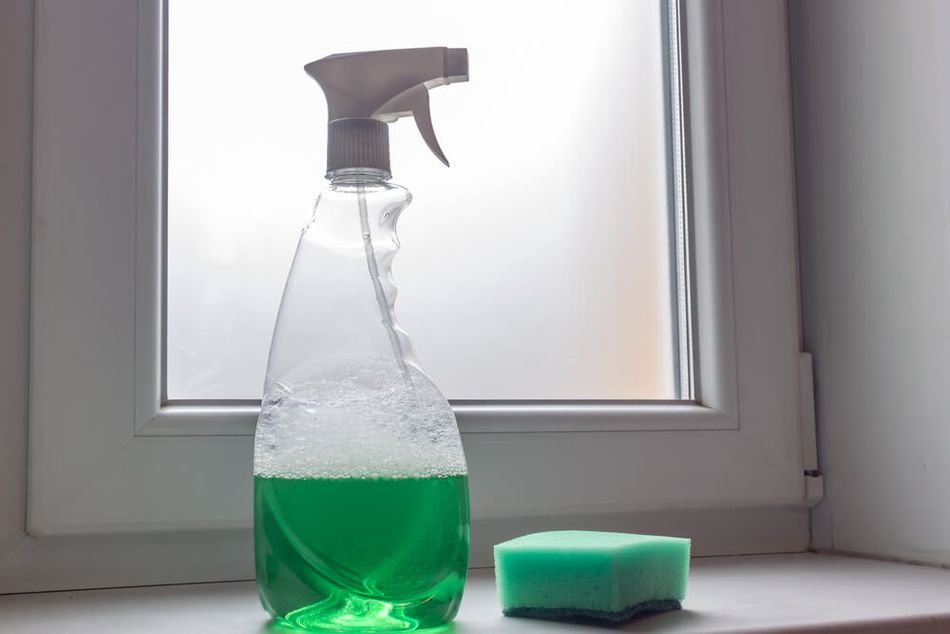How To Clean 3d Printing Bed
In the world of FDM 3D press, the first layer of printing is ofttimes the about of import. Poor first-layer adhesion, which can be caused by wrong scale, too-fast print speeds, or a desperately prepared build surface, is the crusade of many failed prints.
1 of the best means to prevent bed adhesion problems is to maintain a clean build surface. By taking good intendance of the surface, the extruded thermoplastic has a better chance of sticking to it, and the odds of print failure are significantly reduced.
However, information technology's not e'er articulate how to clean a 3D printer bed or its build surface. Unlike print surfaces are made from different materials, which react in different means to certain cleaning solutions. This article goes over the basics of cleaning your 3D print bed, looking at the supplies you'll need and the unlike methods you can use.
Why is 3D printer bed cleaning important?
An FDM 3D printer is fabricated of many parts, but the (literal) foundation of a skilful impress is the print bed.
Usually made of glass or aluminum, the print bed is a solid, flat surface upon which the printed part gets fabricated. In Cartesian-style printers, these beds are square or rectangular, while on Delta-fashion printers they are circular. Sometimes called a build plate, the impress bed can be heated or unheated: a heated bed helps ameliorate outset-layer adhesion and makes it easier to remove the finished print.[1]

Somewhat confusingly, not all FDM users use their built-in print bed as their build surface. The build surface is whatever substrate the nozzle deposits the offset layer of plastic onto; it tin can be the print bed itself, or it can be something else like a removable glass plate, a rigid plastic canvass, or strips of masking record. Furthermore, printer users often care for their build surface with additives like mucilage stick or hairspray to ameliorate adhesion.
When nosotros talk about 3D printer bed cleaning, we may be talking about cleaning the print bed or cleaning the build surface — or both! Cleaning the build surface is important considering a dirty surface with filament buildup can negatively affect adhesion and lead to failed prints. But it is as well important to clean the print bed even if it is not used equally the build surface, as it will ensure a longer lifespan and amend adhesion to removable surfaces like tape and BuildTak.
Impress bed cleaning supplies
Isopropyl alcohol
Isopropyl booze (IPA) is a colorless chemical compound that is often institute in antiseptics, detergents, and disinfectants. It is sometimes chosen "rubbing alcohol" due to its former use as a topical preparation for massages.
FDM users can apply IPA (containing 70–90% alcohol) every bit a cleaning product on print surfaces like glass and PEI. The chemic substance is stiff enough to remove grease and residuum but is unlikely to damage these surfaces.
Acetone
Some other chemical compound used to clean 3D printer beds and build surfaces is acetone, which is found in products like blast varnish remover and pigment thinner. The solvent is as well used as a smoothing amanuensis for ABS prints, as it is able to dissolve the plastic (though it won't cut through PLA).
Acetone can be used to clean drinking glass beds, working well confronting dirt, grease, and some types of plastic filament rest. It may also be used to clean PEI and other surfaces, though it can harm a plastic surface if used too frequently.
Window cleaner

Spray-canteen window cleaners typically contain a form of alcohol such as ethanol or isopropanol, in addition to other grease-dissolving agents. They may also contain additives such equally perfumes, though products with fewer additives are ameliorate for print bed cleaning.
Window cleaning sprays are formulated for the cleaning of glass and tin therefore work well for cleaning glass print beds and surfaces.
Lather
Ordinary dishwashing lather mixed with warm h2o is a cheap and effective solution for cleaning print surfaces of various kinds. Unscented products with minimal additives piece of work all-time.
Equipment
In addition to chemical substances, a few pieces of equipment are needed to make clean a printing surface. Information technology is useful to have the post-obit on mitt:
-
Scraper: A apartment-blade scraper is used to remove rest without damaging the print bed or build surface
-
Sandpaper: More than annoying than a scraper or fabric, sandpaper can help maintain an even surface
-
Cloth: A soft microfiber cloth can exist used to employ various substances to the print bed or build surface
-
Paper towels: Paper towels are suitable for applying mild cleaning agents like soapy h2o and window cleaner
How to clean 3D printer beds
Glass
Glass is one of the most pop and constructive build surfaces, since it distributes heat evenly and is relatively piece of cake to clean. Some printers take glass print beds, while some users affix a removable glass sheet (usually borosilicate glass) to a metallic impress bed.
While glass provides a apartment printing surface, its smoothness can actually foreclose good first-layer adhesion. Because of this, users often utilize glue or another adhesive to the glass surface before press. This naturally creates a buildup of residuum, which should be cleaned between prints.
How to make clean glass 3D printing beds:
-
If possible, remove the glass plate from the print bed to avoid getting cleaning solution in the printer's mechanical parts.
-
Scrape abroad any big pieces of glue or filament residue with a dry scraper, applying firm and fifty-fifty pressure.
-
Use a cleaning material soaked with warm soapy water to clean grease and other residue from the glass about once a month or when required (but only if the surface can be removed from the printer). Alternatively, use window cleaner.
-
While wearing protective gloves, soak a textile with a pocket-size amount of IPA and wipe the surface before each print.
-
Avoid getting fingerprints on the glass where possible.
PEI
Polyetherimide (PEI) is a chemically stable thermoplastic that is used every bit a printing surface due to its good textile characteristics such as estrus resistance. Depression-cost PEI sheets can be fastened to a build plate and concluding many impress cycles.
An advantage of using a PEI sheet over glass is its superior adhesion, particularly with materials like ABS. Typically, no extra agglutinative like glue is used on the surface, which reduces buildup of residue. However, regular cleaning is required to maintain good adhesion.
How to clean PEI 3D printing beds:
-
If possible, remove the PEI surface from the print bed to avoid getting cleaning solution in the printer's mechanical parts.
-
Soak a dry fabric in IPA and wipe the PEI bed surface to remove gunk and balance. Repeat this procedure betwixt prints. Alternatively, use dish lather and warm water.
-
Apply acetone with a textile around once a calendar month to smoothen downward and further make clean the plastic surface.
-
If the surface is scratched, utilise a fine-grit sandpaper to smooth it downwardly. If the imperfections are as well severe to be fixed, replace the PEI sheet.
-
Avoid getting fingerprints on the PEI where possible.
Adhesive tape
Blueish painter'south tape — a kind of masking tape — and NASA-adult Kapton tape are mutual build surfaces for FDM 3D printers that exercise not have heated beds.[2] (A heated bed could melt the glue on the adhesive side of the record.) Despite the improvised wait of a taped print bed, the material works well and tin easily be replaced.
The obvious disadvantage of using agglutinative record is that at that place volition be minor seams betwixt each strip, which tin leave a visible line on the base of operations of a print. However, this trouble can be mitigated to some extent by using thicker tape. Furthermore, the cleaning process for tape is trickier than with solid surfaces like glass, equally tape cannot be treated with solvents or other wet cleaning solutions.

How to clean adhesive record 3D printing beds:
-
Utilize a dry scraper to remove rest and leftover filament.
-
Replace damaged sections of record. If possible, try to go along the surface level and even to avert issues with futurity prints.
-
Avoid getting fingerprints on the tape where possible.
-
Replace the entire tape bed when it is visibly worn, torn, or uneven. Make clean the bed underneath with IPA or acetone to remove gum rest before applying the new layer.
BuildTak
One of the nearly pop branded press surfaces is BuildTak, a low-price, rut-resistant adhesive sheet that is easy to clean and replace. Although its material is not disclosed, users suggest it may be a mixture of PEI and glass.
How to clean BuildTak 3D printing beds:
-
Soak a dry cloth in IPA and wipe the BuildTak surface to remove gunk and balance. Echo this procedure between prints.
-
Try using warm water if the IPA is unsuccessful.[3]
-
Avert getting fingerprints on the BuildTak surface where possible.
-
Supervene upon the BuildTak surface when it is worn and parts no longer adhere to the bed.
Conclusion
There are many impress bed surfaces to cull from, and unlike surfaces suit unlike print jobs. ABS filament works best on surfaces like PEI sheet or BuildTak, but struggles when printed onto a very smooth surface like glass. PLA offers more options, working well on a heated bed with a glass surface.
Whatever surface y'all choose for your 3D print bed, cleaning and maintenance is vitally important — both for the longevity of the surface and for ensuring good first-layer adhesion that will forbid failed prints.
To become the most out of your FDM printer, always have a choice of cleaning supplies on hand, always wipe down difficult print surfaces between prints, and comport out a thorough deep clean every few weeks or months.
References
[1] Nazan MA, Ramli FR, Alkahari MR, Abdullah MA, Sudin MN. An exploration of polymer adhesion on 3D printer bed. InIOP Briefing Serial: Materials Science and Applied science 2017 Jun 1 (Vol. 210, No. i, p. 012062). IOP Publishing.
[two] Teliskova Grand, Torek J, Cmorej T, Kocisko Grand, Petrus J. Adjustments of RepRap type printer workbench. In2017 quaternary International Briefing on Industrial Applied science and Applications (ICIEA) 2017 Apr 21 (pp. xv-19). IEEE.
[iii] How to Clean a 3D Printer BuildTak Surface on the E2 [Internet]. Raise3D Academy. 2021 [cited 2022Mar8]. Available from: https://www.raise3d.com/academy/how-to-clean-a-3d-printer-buildtak-surface-on-the-e2/
Source: https://www.wevolver.com/article/how-to-clean-3d-printer-beds-glass-pei-adhesive

0 Response to "How To Clean 3d Printing Bed"
Post a Comment